https://www.jacc.org/doi/full/10.1016/j.jacbts.2020.04.007

https://jasn.asnjournals.org/content/31/5/931.abstract

https://www.ahajournals.org/doi/10.1161/CIRCULATIONAHA.120.049096
https://www.ncbi.nlm.nih.gov/pmc/articles/PMC5837649/
 Intravascular cNIRF-IVUS imaging with the 4.5F/40MHz catheter reveals the value of IVUS-based distance correction of the NIRF signal in blood. In vivo cNIRF-IVUS imaging of a swine carotid artery was performed following local injection of an NIR fluorophore into the artery wall. Panels (A), (B) and (C) illustrate the in vivo cNIRF image, the corresponding longitudinal IVUS image, and the FRI image of the resected artery, respectively. (D) A 3D representation of the lumen and arterial wall NIR fluorescence signal rendered based on the in vivo cNIRF-IVUS image stack. Insets (C1–C3) show representative examples of the cross-sectional cNIRF-IVUS images corresponding to pullback positions C1, C2, and C3 in (B), (C), and (D). The cNIRF signal in C1, C2, and C3 is fused onto the interior of the IVUS catheter and also replicated at the exterior (outlined with red dotted lines) of the IVUS image. (E) Serial imaging of the same vessel region demonstrates that the raw NIRF signal (top row) is affected by variable intraluminal catheter position that changes the distance between the NIR fluorescence source and imaging catheter detector, leading to fluctuations in the measured NIRF signal. Note that applying the NIRF distance correction (bottom row) substantially improved the reproducibility of the NIRF image and reduced the variability due to changes in catheter position. (F) Quantitative assessment of the improvement of the reproducibility by NIRF distance correction: black dots correspond to the maximum NIRF signal vs. pullback position, and the blue line indicates the average distribution function. Distance correction improved the correspondence between NIRF signals from all three pullbacks from R2 = 0.89 to R2 = 0.96.
Intravascular cNIRF-IVUS imaging with the 4.5F/40MHz catheter reveals the value of IVUS-based distance correction of the NIRF signal in blood. In vivo cNIRF-IVUS imaging of a swine carotid artery was performed following local injection of an NIR fluorophore into the artery wall. Panels (A), (B) and (C) illustrate the in vivo cNIRF image, the corresponding longitudinal IVUS image, and the FRI image of the resected artery, respectively. (D) A 3D representation of the lumen and arterial wall NIR fluorescence signal rendered based on the in vivo cNIRF-IVUS image stack. Insets (C1–C3) show representative examples of the cross-sectional cNIRF-IVUS images corresponding to pullback positions C1, C2, and C3 in (B), (C), and (D). The cNIRF signal in C1, C2, and C3 is fused onto the interior of the IVUS catheter and also replicated at the exterior (outlined with red dotted lines) of the IVUS image. (E) Serial imaging of the same vessel region demonstrates that the raw NIRF signal (top row) is affected by variable intraluminal catheter position that changes the distance between the NIR fluorescence source and imaging catheter detector, leading to fluctuations in the measured NIRF signal. Note that applying the NIRF distance correction (bottom row) substantially improved the reproducibility of the NIRF image and reduced the variability due to changes in catheter position. (F) Quantitative assessment of the improvement of the reproducibility by NIRF distance correction: black dots correspond to the maximum NIRF signal vs. pullback position, and the blue line indicates the average distribution function. Distance correction improved the correspondence between NIRF signals from all three pullbacks from R2 = 0.89 to R2 = 0.96.
The laboratory of Farouc Jaffer, MD, PhD, in the Cardiovascular Research Center at Massachusetts General Hospital is developing bench-to-bedside approaches to image and understand in vivo inflammation and thrombogenesis in vascular disease, including atherosclerosis, venous thrombosis, and arteriovenous fistula.
Through close collaborations with molecular imaging chemistry experts, we have developed an array of molecular imaging agents to report on macrophages, fibrin, cathepsin K, VCAM-1, thrombin, and activated factor XIII. Using intravital microscopy, FMT, MRI or PET-CT, we have imaged and quantified these molecular targets in murine models of vascular disease, which have led to new insights into how atheroma, thrombi, and AVF evolve and resolve.
Our major translational efforts focus on developing intravascular near-infrared fluorescence molecular imaging catheter technology to image inflammation in human coronary arteries and coronary stents, using large animal models. In conjunction with world-leading engineering groups, we have developed intravascular NIRF-OCT and NIRF-IVUS catheters and systems. The ability to image inflammation at high-resolution could provide new approaches to identify high-risk plaques and high-risk stents.
Our clinical research efforts focus on improving percutaneous coronary intervention success for chronic total occlusions, radial artery catheterization, and improving the treatment of microvascular coronary disease and microvascular angina.
